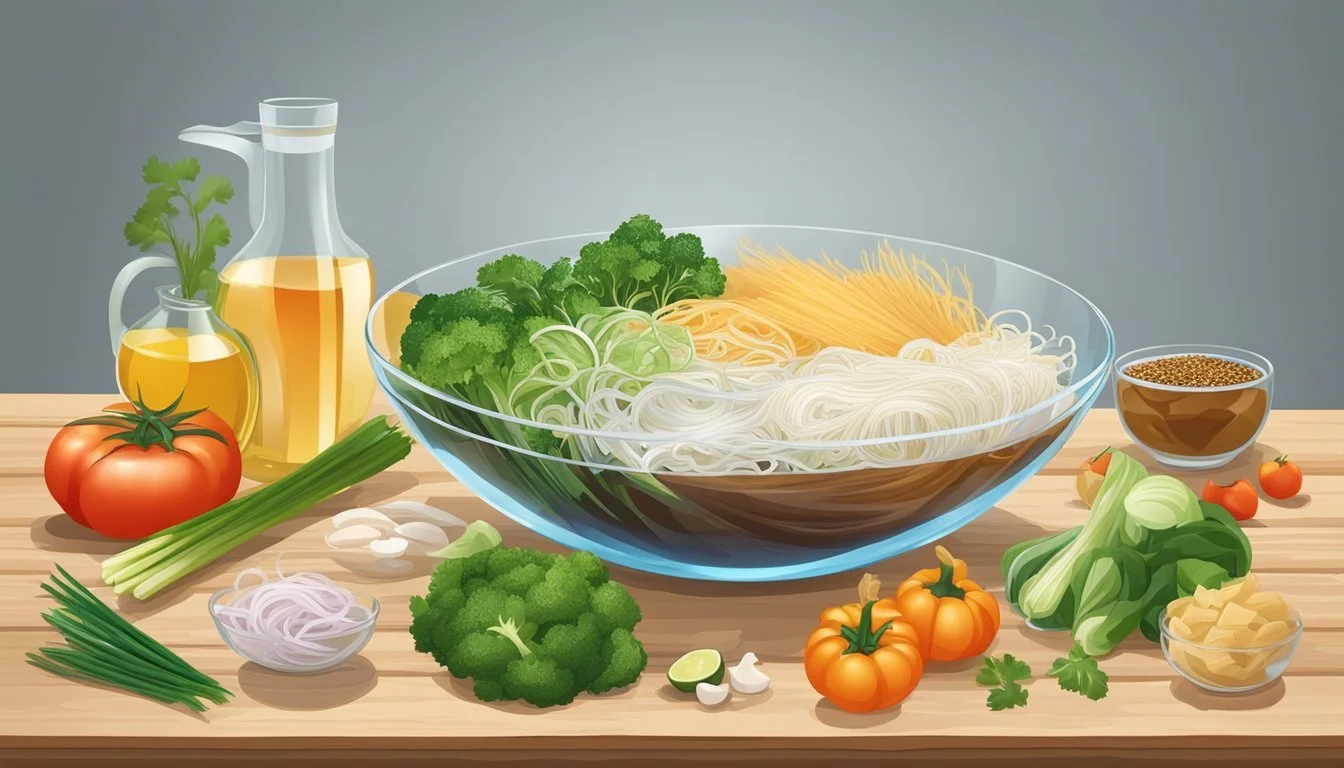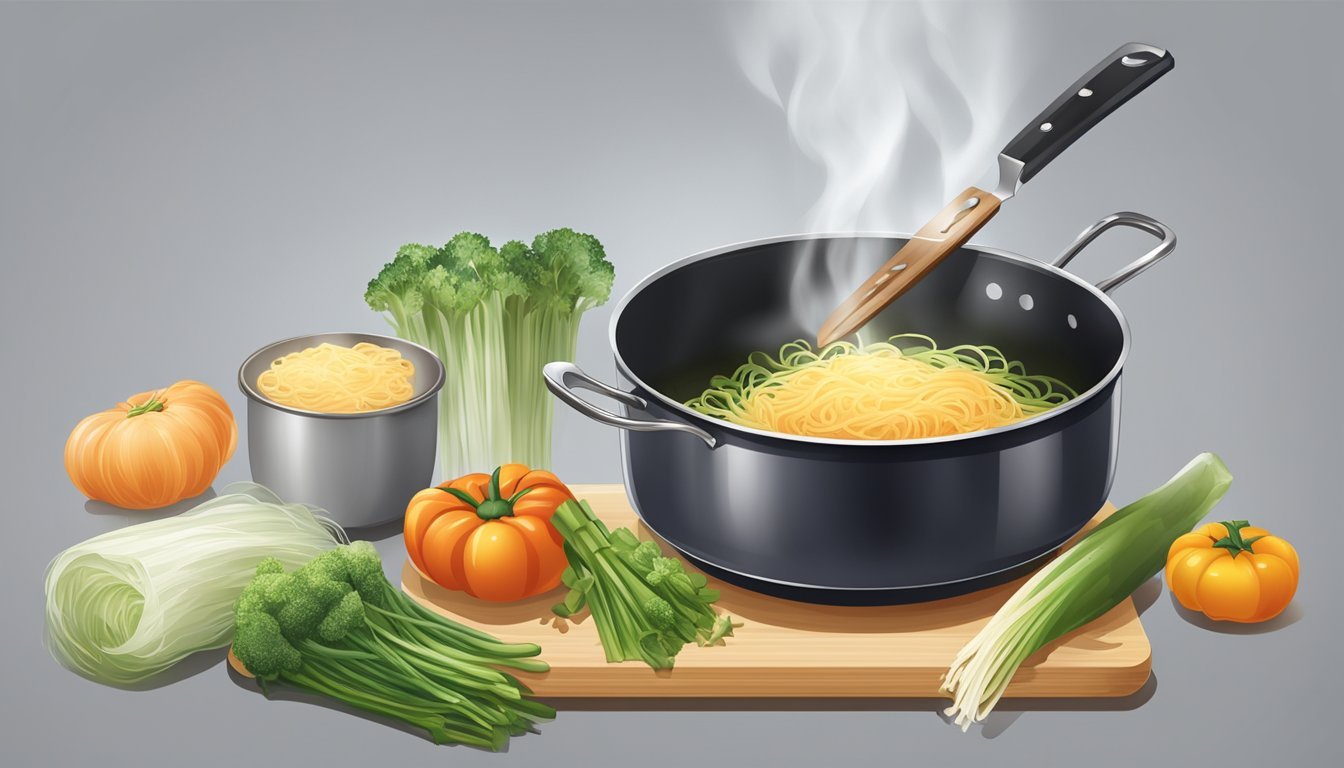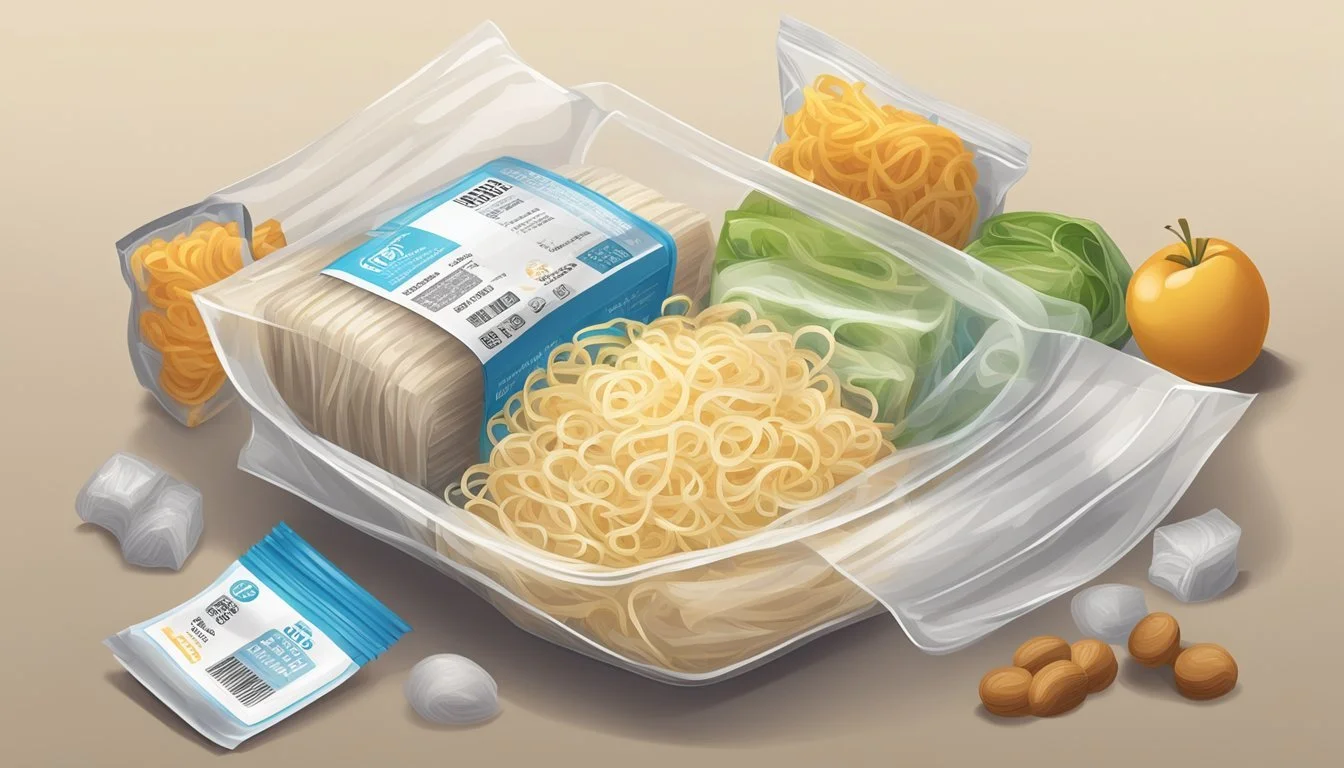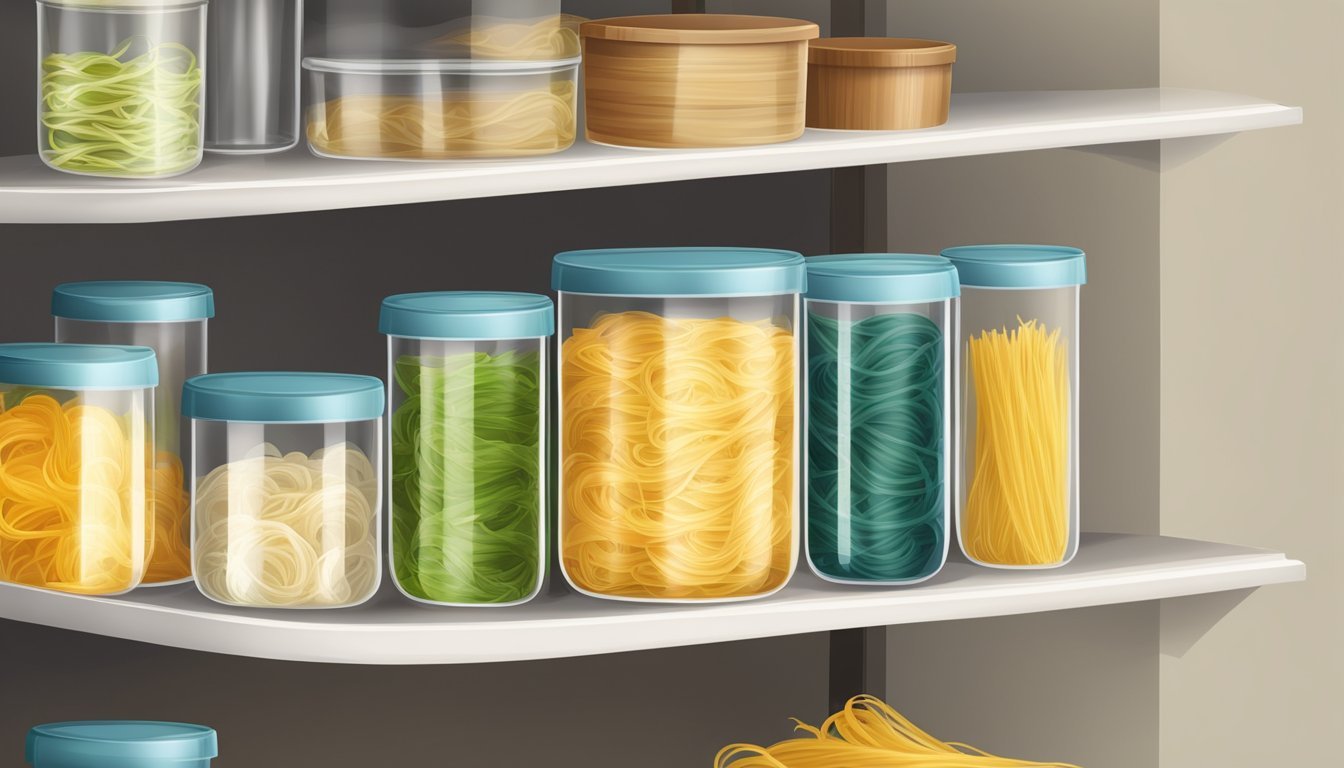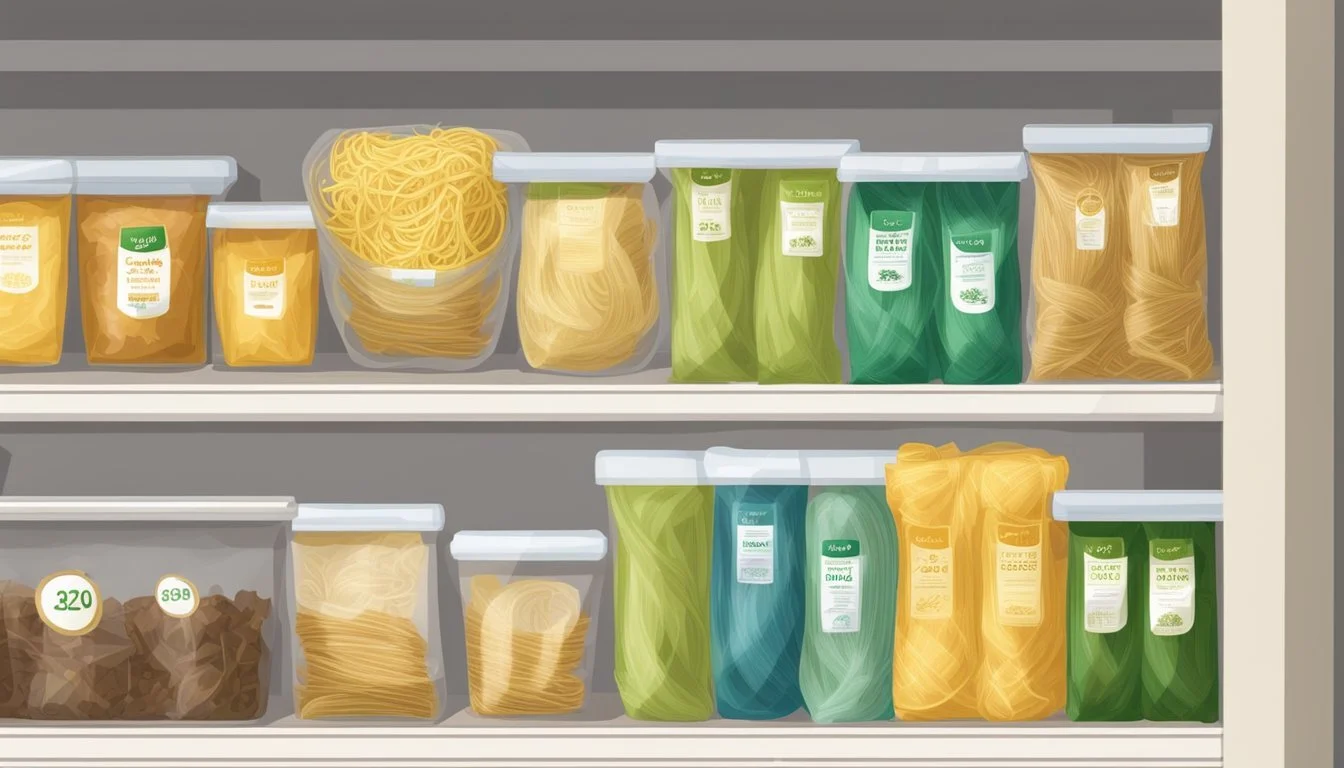How Long Do Glass Noodles Last?
Shelf Life and Storage Tips
Glass noodles, also known as cellophane noodles, bean thread noodles (how long does bean thread noodles last?), or vermicelli, are a staple in Asian cuisine with a presence in Korean, Chinese, Japanese, Thai, and Vietnamese dishes. Made from water and starch such as mung beans, potatoes, sweet potatoes (What wine goes well with sweet potatoes?), or tapioca, these transparent noodles are notable for their unique texture and versatility in a variety of dishes ranging from stir-fries and soups to cold salads and spring rolls.
The shelf life of glass noodles is a point of interest for those who stock their pantries with this Asian culinary essential. Uncooked glass noodles can last a significant amount of time when stored properly in a cool, dry place, remaining suitable for use well beyond the purchasing date. They are a non-perishable item until opened or cooked, somewhat similar to other dried pasta, which makes them a practical ingredient for those looking for longevity in their noodle selection.
Once cooked, however, glass noodles follow the standard food safety guidelines that apply to most prepared dishes. Refrigeration is necessary to extend the lifespan of the cooked noodles and to prevent spoilage. The general recommendation is to consume cooked glass noodles within a few days, ensuring they retain their quality and are safe to eat. Careful storage and prompt usage are key to maintaining the integrity of glass noodles in both their raw and cooked forms.
Composition and Types
Glass noodles, known for their translucent appearance once cooked, are primarily made from starch. Their unique texture and versatility make them a staple in various Asian cuisines.
Main Ingredients
The main ingredients in glass noodles are starches derived from different sources:
Mung Bean Starch: Traditional glass noodles, also referred to as bean thread noodles or cellophane noodles, utilize mung bean starch, which contributes to the noodles' gelatinous texture.
Potato Starch and Sweet Potato Starch: Some versions use potato or sweet potato starch, which provides a slightly different texture and flavor profile.
Tapioca: Occasionally, tapioca may be added to the starch mixture to achieve the desired chewiness and elasticity.
Variants Across Asian Cuisines
Glass noodles manifest in a variety of forms across Asian dishes, each with subtle differences:
Chinese Vermicelli: Often made from mung bean starch, these are a thin, clear noodle used in soups, stir-fries, and spring rolls.
Korean Japchae Noodles: Utilize sweet potato starch, presenting a chewier texture and are a key ingredient in the dish Japchae.
Thai Glass Noodles: Usually made from mung bean or tapioca starch (how long does tapioca starch last?), they are an essential component in salads and soups.
Vietnamese Rice Vermicelli: Although not as transparent as typical glass noodles, they are made from rice and used in a variety of dishes such as bún chả and spring rolls.
Cooking and Preparation
Cooking glass noodles properly ensures their optimal texture and flavor in a variety of dishes. The third person will now guide the reader through the two primary methods of preparing glass noodles, boiling and soaking, as well as how to incorporate them into meals.
Boiling and Soaking Methods
Boiling: To cook glass noodles, one can boil them in water for about 3 to 5 minutes, until they are soft. It's vital to avoid overcooking, as glass noodles can become too soft and lose their desirable texture.
Bring a pot of water to a rolling boil.
Submerge the glass noodles and let them cook for the recommended time.
Soaking: Alternatively, noodles can be soaked in boiling water off the heat. They should be fully submerged in a bowl of hot water for 10 to 15 minutes or until they reach the desired softness.
Pour boiling water over the noodles into a heatproof bowl.
Allow them to soak and expand.
Incorporating Into Dishes
After preparation, glass noodles are versatile and can be seamlessly incorporated into various recipes. They can be stir-fried with vegetables and protein or added to soups and salads for a textural contrast.
Stir-fries: For stir-frying, one should slightly undercook the noodles during boiling or soaking since they will continue to cook and absorb flavors in the wok.
Soups: When used in soups, it's best to add soaked noodles toward the end of cooking to prevent over-softening.
Salads: For cold dishes like salads, noodles should be cooked, then cooled under running water to stop the cooking process before tossing with other ingredients.
Nutritional Information
Glass noodles, known for their unique texture and versatility in Asian cuisine, provide a distinct nutritional profile. They are particularly notable for being gluten-free and having a specific caloric and carbohydrate content, which pertains to those monitoring their dietary intake closely.
Caloric and Fiber Content
A typical serving size of cooked glass noodles, which is approximately one cup, contains around 160 calories. Despite their caloric content, they have a minimal fiber content, which indicates that they are not a significant source of dietary fiber.
Vitamins and Carbohydrates
In terms of vitamins, glass noodles do not stand out as a rich source; they do not contain significant levels of B vitamins or other vitamins. However, when considering carbohydrate content, one cup of cooked glass noodles has about 39 grams of carbohydrates. Their gluten-free nature makes them a suitable alternative for individuals with celiac disease or gluten sensitivity.
Culinary Uses
Glass noodles are prized for their unique texture and versatility, used in an array of Asian cuisines. They provide a gluten-free alternative to wheat-based noodles and absorb flavors well, making them ideal in a diversity of dishes.
Traditional Asian Dishes
In Asian cuisine, glass noodles are commonly used in many traditional dishes. Japchae, a classic Korean stir-fry dish, features glass noodles made from sweet potato starch that are stir-fried with vegetables, often spinach, carrots, and mushrooms (What wine goes well with mushrooms?), and typically seasoned with soy sauce and sesame oil (how long does sesame oil last?). They're also a staple in Chinese hot pots, offering a delicate yet satisfying texture to the communal broth-based cooking.
Spring rolls and summer rolls often encase these noodles alongside vegetables, herbs, and sometimes meats or shrimp, (What wine goes well with shrimp?) wrapped in rice paper (how long does rice paper last?). The noodles' elasticity complements the fresh ingredients, dipped in a variety of sauces like hoisin or peanut sauce. Additionally, they serve as a filling for various dumplings across Asian cuisines, valued for their slippery, chewy texture.
Fusion and Modern Recipes
Chefs frequently incorporate glass noodles in innovative fusion and modern recipes. They have become popular in contemporary noodle salads, where they are tossed with a mix of raw vegetables, protein like chicken or tofu, and a tangy dressing, providing a refreshing meal that's both light and satisfying.
In reinterpretations of classics such as Pad Thai, glass noodles can replace the traditional rice noodles (how long do rice noodles last?), offering a different mouthfeel and visual appeal while still absorbing the iconic tamarind and fish sauce- (how long does fish sauce last?) based flavors. They also make an appearance in stir-fry dishes, where they gracefully intertwine with a variety of meats, vegetables, and sauces, showcasing their ability to take on bold flavors and contribute to the textural experience of modern Asian-inspired cuisine.
Textural and Flavor Profile
Glass noodles offer a unique combination of texture that transforms from opaque to translucent upon cooking, and they are prized for their ability to soak up robust flavors from sauces and seasonings.
Consistency After Cooking
After being cooked, glass noodles typically exhibit a transparent and gelatinous appearance with a markedly slippery texture. When boiled for 3 to 5 minutes or soaked in hot water, the noodles become soft yet retain a chewy resilience. This textural contrast allows them to contribute a satisfying mouthfeel to a variety of dishes.
Flavor Absorption and Pairing
A standout characteristic of glass noodles is their exceptional capacity to absorb flavors. They have a relatively neutral taste, making them an ideal canvas for a range of sauces, from savory soy sauce to sweet and tangy profiles. They pair well with bold ingredients like peanut, sesame oil, and garlic, which cling to the noodles' translucent strands, ensuring each bite is infused with the intended flavors of the dish.
Shelf Life and Storage
Glass noodles, also known as cellophane or bean thread noodles, have a remarkable shelf life when stored correctly. The key to their longevity is ensuring they remain in a cool, dry place, away from moisture and heat which can degrade their quality.
Uncooked Noodle Storage
When uncooked, glass noodles have an indefinite shelf life if they remain unopened in their original packaging. To ensure maximum freshness, they should be stored in a:
Cool: Below room temperature but above freezing.
Dry: Low humidity to prevent clumping or degradation.
Dark: Away from direct sunlight to avoid any heat buildup.
Ideal storage conditions may include a pantry, kitchen cabinet, or a storeroom that stays consistently dark and temperate. If the original packaging is compromised, transferring the noodles to an airtight container can help maintain their quality.
Best Practices After Cooking
Once cooked, the storage approach for glass noodles changes significantly. Leftovers, such as cooked leftover japchae, should be:
Cooled Down: Before storage, allow the noodles to reach room temperature.
Refrigerated: Store in airtight containers to retain moisture and prevent contamination.
Time-Sensitive: Consume leftovers within 3 to 5 days to ensure safety and quality.
Reheating cooked glass noodles is straightforward; they can be warmed in a microwave or briefly sautéed. However, moisture loss can occur during reheating, so adding a small amount of water can help retain their texture.
Dietary Considerations
Glass noodles, known for being low in fat and calories but high in carbohydrates, cater to various dietary needs. They offer versatility for vegan and vegetarian diets, and provide clear allergy information for those with food intolerances.
Vegan and Vegetarian Options
Glass noodles are inherently plant-based, as they are made from starch such as mung bean, potato, or tapioca, and water. Vegans and vegetarians can include them in their diets as a substitute for noodles that may contain eggs or animal-based additives. To enrich these noodles with protein, one could add tofu, a soy-based product that is a staple in vegan and vegetarian cuisine.
Common Vegan Additions:
Tofu (firm or silken)
Mixed vegetables (e.g., bell peppers, spinach, broccoli)
Common Vegetarian Additions:
Eggs (scrambled or boiled)
Dairy (such as a sprinkle of cheese)
Allergy and Intolerance Information
Glass noodles are a suitable option for individuals with celiac disease or gluten intolerance as they are gluten-free by nature. However, one should be cautious of cross-contamination or the addition of sauces that may contain gluten. When adding protein sources like shrimp, pork, or chicken, it's essential to ensure these additions are free from marinades or seasoning mixes containing allergens such as soy, nuts, or dairy for people with other specific food allergies.
Allergen-Free Protein Additions:
For Seafood Allergies: Opt for poultry like chicken or alternative proteins like tofu.
For Soy Allergies: Choose pork, shrimp, or chicken, prepared without soy-based sauces.
Shopping Guide
When purchasing glass noodles, consumers should focus on the quality of the product and decipher the labels for optimal selection. Here's how one can identify the best choice for their culinary needs.
Selecting High-Quality Noodles
Shoppers should inspect the glass noodles' texture and color: quality glass noodles typically have a consistent, smooth texture and are either clear or have a slight brownish tint. They are most commonly found in Asian markets or the international aisle of a supermarket. When comparing to other types, such as angel hair pasta, glass noodles should appear dry and stiff in the package, gaining their gelatinous quality only after being cooked.
Understanding Labels and Brands
The labels on glass noodle packages can reveal their composition, which affects both flavor and durability. Names like dangmyeon, harusame, and Chinese vermicelli indicate different types of glass noodles made from ingredients like sweet potato starch, mung bean starch, or peas. Brands often have a reputation for quality; hence, familiarizing oneself with recognized brands in the market can guide buyers towards a better product. It is advisable to read the labels carefully for cooking instructions and storage guidelines to ensure maximum freshness and longevity.
Culinary Techniques
Glass noodles, known for their unique transparency and delicate texture, are a staple in various Asian dishes. Their versatility allows for a wide range of cooking methods, adapting well to stir-frying and incorporation into soups and salads.
Tips for Stir-Frying
When one stir-fries glass noodles, preparation is crucial. They should first soak in boiling water for about 5 to 10 minutes, with the goal being to soften them but not cook them completely. Once they have a pliable texture, they can be swiftly stir-fried with vegetables and proteins, absorbing flavors and sauces effectively. It's important to stir-fry over high heat for a short amount of time to avoid overcooking, as glass noodles integrate quickly with other ingredients.
Making Noodle Soups and Salads
For soups, glass noodles are added towards the end of the cooking process. They should be soft enough to eat but still retain some chewiness. They will typically require just a few minutes in the hot broth to reach the desired consistency. In salads, glass noodles should be fully soaked and cooled before being mixed with the other components. This ensures that the noodles don't clump together and are evenly coated with the dressing, herbs, and spices of the recipe.
Pairing with Other Foods
Glass noodles, known for their versatility, complement a wide array of ingredients. They absorb flavors well, making them ideal for pairing with various vegetables, meats, and seafood.
Vegetables and Mushrooms
Glass noodles elevate their taste when paired with an assortment of vegetables and mushrooms. Popular choices include:
Stir-Fry Vegetables: Carrots, bell peppers, and spinach offer a colorful and nutritious addition.
Mushrooms: Oyster and shiitake mushrooms bring a meaty texture and umami flavor.
One can mix these vegetables and mushrooms with glass noodles in stir-fries or salads, enhancing the dish with both flavor and visual appeal.
Meats and Seafood
Protein acts as a cornerstone of many glass noodle dishes, providing a substantial texture contrast.
Meat: Thinly sliced pork or chicken are commonly stir-fried with glass noodles.
Seafood: Shrimp adds a delicate, sweet flavor that pairs beautifully with the noodles' gentle chewiness.
Tofu: For a plant-based protein, tofu can be a great meat alternative, adding a gentle soy flavor and additional texture to the dish.
These proteins can be marinated, pan-fried, or grilled before being combined with glass noodles, ensuring a rich and satisfying meal.


